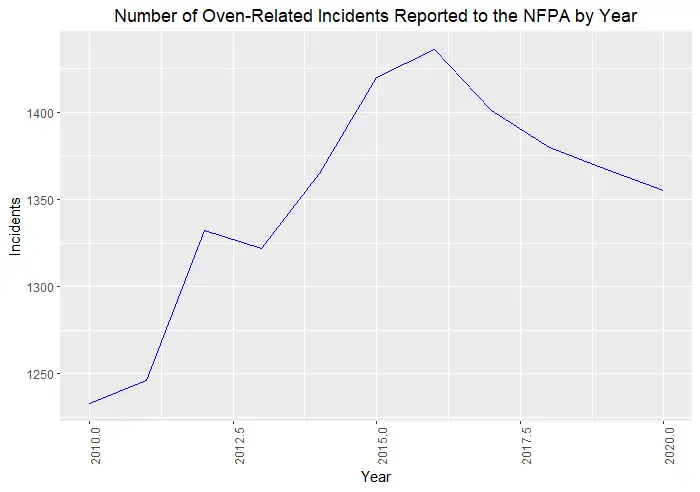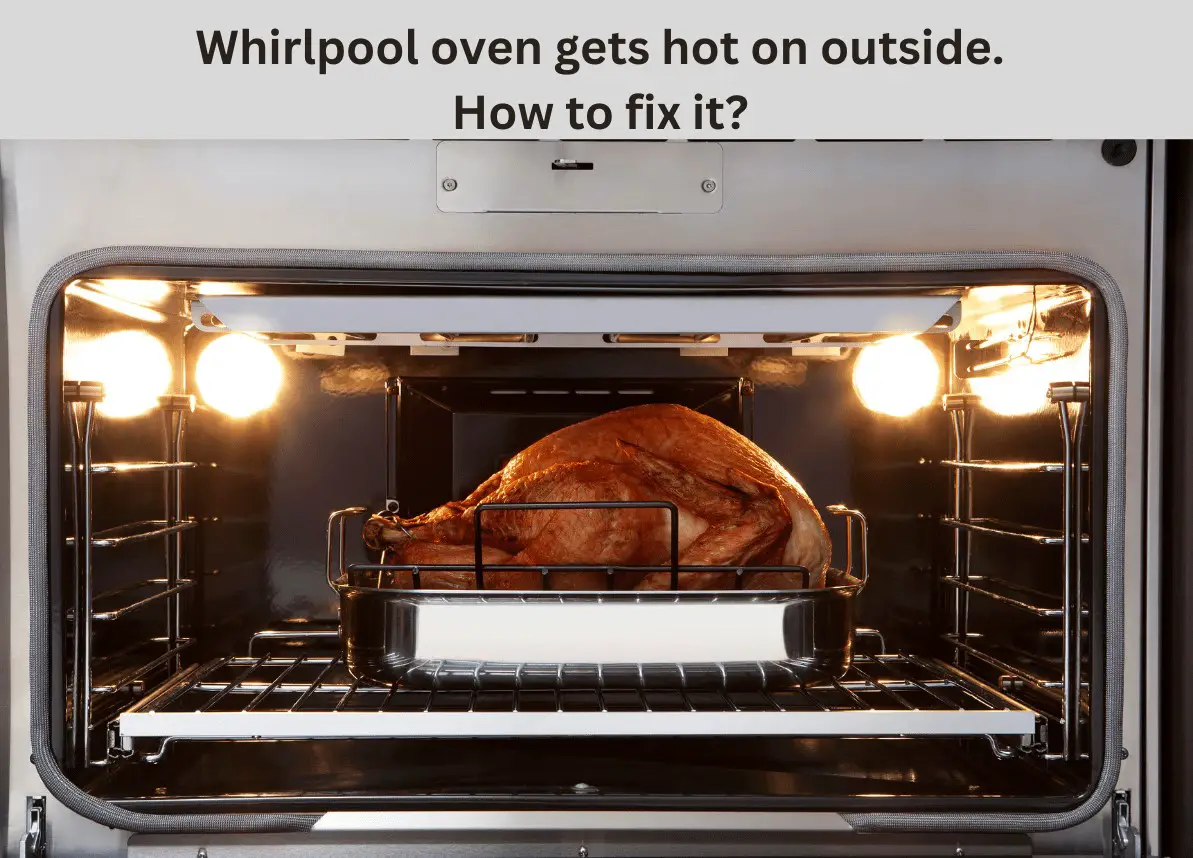Whirlpool ovens have become the trend of the town. And for good reasons. They are safe, reliable, and energy efficient.
But sometimes, Whirlpool ovens show annoying errors or malfunction. For example, your oven may get very hot on the outside. So hot that you find it hard even to touch the oven knobs.
So, Why do Whirlpool ovens get hot on the outside? This blog post will talk about 4 common reasons why it so happens and will give you DIY fixes for those problems.
Why does the Whirlpool oven get hot on the outside?
Your Whirlpool oven gets hot on the outside either because of poor insulation, blockage in the ventilation, faulty heating element, or malfunctioning the thermostat. All these issues can be fixed following the tips in this blog post.

4 causes of the problem
1. Poor insulation
In my experience, the most frequent reason for Whirlpool ovens getting hot on the outside is poor insulation.
Damaged or worn-out insulation around the oven can cause heat to escape and make the exterior hot to the touch.
It makes the oven hot on the outside and asks the oven to work harder (i.e., consume more energy) to maintain its internal temperature.
2. Overheating of the heating elements
As you know, a heating element is a component inside an oven that increases the oven’s internal temperature by receiving commands from the control unit. A faulty control unit may lead to several problems, such as malfunctioning of the probe.
In case of a heating element malfunctioning, the heating element can get too hot (thus increasing the temperature beyond the desired limit). The oven’s exterior may also become very hot in such a case.
Sometimes, a problem with the thermostat or the oven’s temperature sensor may also be the culprit. A problem with the thermostat or the temperature sensor eventually forces the heating element to raise the temperature.
3. Blockage of ventilation
Any home appliance that produces heat requires ventilation. And ovens are no exception to it.
The ventilation system of the ovens is meant to dissipate the heat by circulating cool air and, thus, keep the interior and exterior of the oven from overheating.
Any blockage in the ventilation stops the cool air from going around the oven, consequently stopping heat dissipation. The ventilation may be blocked due to food, debris, or oil accumulation in the ducts.
4. Malfunction of the thermostat
So, what sets the temperature to your desired range? The thermostat. And what if the thermostat is not functioning properly? Of course, the temperature of the oven would go uncontrolled.
A thermostat may have software or hardware problems. Or sometimes, it could be the control board of the oven that misinterprets the signals from the thermostat. In either case, the heating element will continue to heat the oven.
Signs of the problem
1. Surface of the oven is hot to touch
The first indication for most people is an excessively hot oven surface. The metal frame around the knobs, the sides of the oven, and even the knobs can feel very hot.
In some cases, the temperature on the outside frame of the oven can go up to 180 F! If you feel your oven’s surface is abnormally hot, it is a sign that something is wrong with the oven’s heating system or the ventilation.
2. Increased temperature in the kitchen
I often receive calls from clients complaining that their kitchen temperature is much higher than the rest of the house.
And my answer is usually a one-liner, “Please check the ventilation or insulation of your oven.”
When the oven fails to dissipate the heat, its outside becomes hot, and the heat starts warming up the kitchen.
Under normal circumstances, the temperature inside the kitchen should not exceed 10-15 F above the room temperature. If it goes above that limit, check your oven immediately.
3. Smoke or burning smell
This might surprise you, but the second biggest cause of home fires in the US is the malfunctioning of ovens!!
If you notice some smoke or burning smell from your oven, it strongly indicates that it isn’t functioning properly.
Immediately disconnect the oven from the power supply. The oven could be hot outside, which may also lead to fire hazards.
4. Unusual noises are coming from the oven.
I have frequently observed that blockage of ventilation or a damaged heating element may cause weird noises in the oven.
If you hear unusual buzzing sounds in your oven, it might signal that the heating element is not working properly or the oven has to work extra hard to dissipate the heat.
Under such a circumstance, the oven has become too hot on the outside or will become so soon.
Solutions
1. Check and clean the ventilation
- Locate the vent on the back or bottom of the oven. Visually check if the ventilation is blocked.
- A good way to check the ventilation is by using a flashlight to look inside. Remove any debris or blockages.
- Once the debris has been removed, please clean the vent with a soft brush. You may also use a vacuum cleaner with a soft brush attachment.
- Sometimes, oil is deposited on the vent ducts and the fan blades. Clean that using the same procedure.
- It is recommended to repeat this cleaning exercise at least twice a year.
2. Inspect and repair insulation
- Once you have ensured that the ventilation is fine, it is time to check the oven’s insulation.
- Like the ventilation ducts, the oven’s insulation can be checked visually without any instrument.
- In most cases, the oven’s insulation is present around the oven.
- Check for any damage or wear and tear on the insulation.
- If it is slightly damaged, you may want to seal the insulation using any sealant.
- If it is damaged at multiple points, it is better to replace the insulation.
- You may also use instruments like thermographs, thermometers, or calorimeters to check the insulation of the oven (all these instruments measure the heat).
3. Replace faulty heating elements
Faulty heating elements are often the culprits (for the reasons discussed above). And if a heating element is not working properly, you may need to change it.
But how would you test whether your oven’s heating element is faulty?
Well, here are 3 quick ways to know this.
Visual inspection: See if the heating element is damaged or bent. If so, it strongly indicates that the heating element needs to be changed.
With the help of a multimeter test: If there are no visible signs of wear and tear in the heating element, you may want to conduct a multimeter test.
Set the multimeter to the resistance setting. Touch the multimeter’s probes to the terminals on the heating element. The reading should be within the range specified in the oven’s manual.
If not, the heating element is faulty and must be replaced.
With the help of a team[erature test: Use an oven thermometer to measure the temperature inside the oven.
Note down the temperature. Preheat the oven to the desired temperature. Now, check the temperature again.
If the temperature is higher (or lower) than the preheat temperature (as mentioned in the Whirlpool oven manual), it indicates that the heating element is faulty.
4. Calibrate or replace the thermostat
If everything else of fine, you may want to calibrate the oven’s thermostat. This usually varies from model to model, so you may want to see the manual of your Whirlpool oven.
Conclusion
To sum up, your Whirlpool oven gets hot outside, likely because of damaged insulation, blocked vents, or a damaged heating element. These issues can be easily fixed by following the instructions in this post.
Remember, it is not advisable to ignore overheating of the oven. Not only that, it could cost you more energy bills, but it may also cause a potential fire hazard.
If you have any further questions, please write in the comments below, and I shall be happy to respond.
Happy cooking!







Just bought a new whirlpool electric range, the temperature on the outside is 135 degrees , very hot to the touch. This is second one within a week. Should I return to Best Buy? My other appliances are whirlpool. Is the heating problem solvable or switch to another brand. Is this a fire hazard?